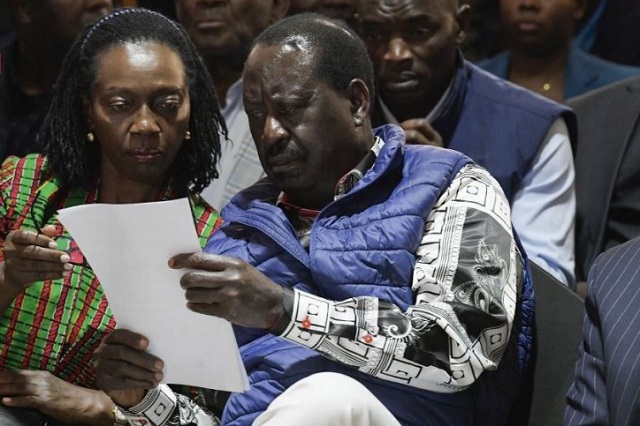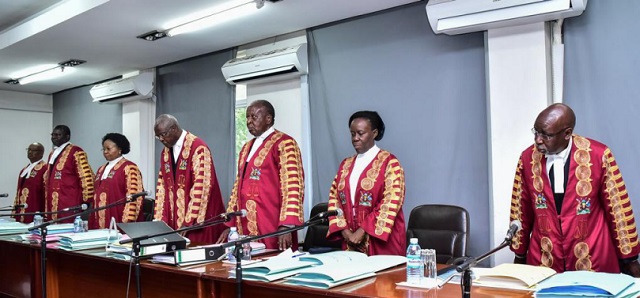
A comparison of Uganda and Kenya’s presidential election maneuvers
Kampala, Uganda | IAN KATUSIIME | After a dramatic last day filing of his presidential election petition at the Supreme Court of Kenya challenging the outcome of the Aug.9 election, Raila Odinga was caught in the middle of a range of scenarios that could arise out of his third presidential election petition.
While at a rally in Mombasa, campaigning for his coalition candidate, Raila said the Supreme Court should declare him president-elect. This is in contrast with his petition which is seeking for a nullification of president-elect William Ruto’s win as declared by the Independent and Electoral Boundaries Commissioners (IEBC).
Raila’s pronouncement is also a contradiction of his own petition where he acknowledges that his rival Ruto got more votes than him but not with the constitutionally required 50% plus one. The petition and the maneuvres by the two rival politicians offers a window into the undercurrents Kenya’s highest court finds itself in after the bruising election that was held this month.
Ugandans are watching events in Kenya because the country’s Supreme Court set a precedent on the continent when it annulled the presidential election of 2017 where Raila was contesting against now retiring President Uhuru Kenyatta.
Raila’s petition is premised on some major areas; how four commissioners of the IEBC disowned the final result announced by the IEBC Chairman Wafula Chebukati, how Chebukati usurped the role and function of the commission in announcing results not verified by the commission, how Chebukati announced a final result without tallies from 27 constituencies.
The petitioners add that the IEBC had not received, uploaded or made publicly available for scrutiny on the public portal of the IEBC, Forms 34A in the 27 constituencies. The 34A Forms are Kenya’s equivalent of Declaration of Results (DR) forms used in Ugandan elections.
The grievances by the Azimio coalition led by Raila and his running mate Martha Karua are the same as those voiced by Dr Kizza Besigye, four time presidential candidate in Uganda. Bobi Wine had the same issues when he filed an election petition challenging results of the 2021 presidential elections.
In going to the Supreme Court for the third time, analysts have argued that Raila is demonstrating his faith in the role of institutions in shaping Kenyan democracy which he has been at the centre of for the last thirty years. The first time he went to the Supreme Court in 2013, he challenged Kenyatta’s presidential election, and the court rejected his petition unanimously.
In 2017, Raila challenged Kenyatta’ re-election in the Supreme Court and the election was annulled forcing a re-run the opposition politician boycotted.
In this petition, Raila is banking on among other things an affidavit sworn by John Githongo, a former Kenyan ombudsman and civic activist, who has a testimony of how hacking into the IEBC portal was conducted.
According to the affidavit, a young man confessed to being part of a team of 56 techies that worked tirelessly to hack into the IEBC and ensure William Ruto is elected President. “We would manipulate and then we send whatever we wanted to send to the public portal so that people would actually download and add the results themselves,” the witness told Githongo.
The young man, according to the affidavit, said that all the forms in the public portal of the IEBC were manufactured by his team in damning revelations that some have called “the smoking gun” in the alleged election fraud.
The young man was allegedly hired by Dennis Itumbi, a key strategist of Ruto, the deputy president, who was declared Kenya’s president-elect by the electoral body.
Ugandan elections have been dogged by similar allegations of vote manipulation although not with the same sophistication as being talked about in Kenya. A few days to the 2021 election in Uganda, the government shut down the internet in a bid to neutralise online platforms which are dominated by opposition actors and supporters.
At the time, Bobi Wine’s National Unity Platform (NUP) and its red wave held sway on Twitter and Facebook leaving the Ugandan government in a tight corner. Facebook remains suspended in Uganda.
The election petitions filed by Dr Besigye in 2001 and 2006 did not have affidavits that purport to incriminate to the level of the one filed by Githongo for the Azimio petition in Kenya. However, the petitions in Uganda’s case have been conducted in an environment of terror, fear and violence. Besigye filed a petition in 2001 after a very violent election where his agents and supporters were beaten, arrested and tortured.
Shortly after his petition was not granted, Besigye fled into exile to South Africa for five years. In 2006, Besigye’s petition was dismissed in a narrow 4-3 majority. It was after a grueling election where he was arrested on return from exile and faced charges of rape, treason, and illegal possession of firearms.
Fast forward in 2021 and Bobi Wine’s petition was even filed in more dire circumstances. Hundreds were shot on the streets in protests in 2020 and more of the young politician’s close associates and supporters were in jail when he went to court challenging the declaration of Museveni as the winner of the highly contested election. Shortly after, Bobi Wine withdrew his petition.
“And yes we went to the Supreme Court to get two things: either to get justice or to get opportunity to expose the judiciary,” Bobi Wine said after what he said was a frustrating encounter with the highest court in the land.
In his application to withdraw, he cited abduction and torture of his witnesses by state agents, actions of Uganda Police and National Identification Registration Authority (NIRA) to spy and infringe on privacy of his witnesses and associates, and the rejection of his application by the Supreme Court to file additional affidavits.

The maths and the politics
After Raila filed his papers in the Supreme Court, lawyers debated the merits of his petition. Raila and team said Ruto did not win with the legally required tally of 50%+ 1 for one to be declared president. According to Azimio coalition, Ruto got 49.9%, decimals shy of the threshold.
“Even based on the disparities in the fraudulently manipulated numbers of the voter turn-out, the petitioners state that the 9th respondent (William Ruto) did not attain the constitutional threshold of 50% plus 1 of the valid votes cast,” the petition read.
Prominent Kenyan lawyer Ahmednasir Abdullahi who represented President Kenyatta in the 2017 election petition seized on this part of the petition to take a swipe at Raila’s case. “In a nutshell Hon Raila in his petition admits that President elect William Ruto won the election but did not attain 50% plus 1 constitutional threshold. He contends Ruto got 49.9 …fussy maths…i told you.” he tweeted.
The four commissioners who distanced themselves moments before the IEBC chair Chebukati declared the final result got a lot of flak for fumbling with the vote tallies. In the petition, all the commissioners of the IEBC are listed as respondents. Those following the petition are waiting to see the positions the commissioners will present when the arguments commence.
Raila who ran for the fifth time, has castigated IEBC chair Chebukati saying he should step aside from any further electoral duty.
“Throughout his tenure as the chairperson of the IEBC, Mr Chebukati has had acrimonious public disagreements with critical members of the commission, including Commissioner Roselyn Akombe who resigned in 2017 in the middle of an election; Commissioners Connie Maina, Margaret Mwachanya and Paul Kurgat who resigned in 2018; Ezra Chiloba the CEO/Secretary; and now Juliana Cherera, Justus Nyangaya, Francis Wanderi and Irene Massit,” the petition states.
Some have argued that the Ruto and IEBC teams will cite Raila’s refusal to take part in the re-run in 2017 as court determines the case. Others have argued that the small margin between the two candidates- 230,000 votes makes the possibility of a recount more tenable than that of a repeat election where the Kenyan presidential election has been cited as one of the most expensive in the world.
The Kenyan Supreme Court has a 14 day window in which to determine its petition according to the constitution. This leaves the court with a somewhat politically sensitive decision to make in a narrow period.
Observers of Kenya’s democracy and political space over the years say the country’s democratic struggles over the years is what made the unpredicted nullification of an election possible in 2017. Presidential term limits and a new constitution in 2010 changed Kenya’s body politic significantly.
Kenya also took a bold new step when its Judicial Service Commission decided to vet judges publicly as a way of enhancing transparence. Members of the public are free to fire questions at potential judges during the vetting process meaning it leaves little chance for those with dents to their name, according to those who have witnessed the proceedings.
Arguments have been made about the subsequent distance between the judiciary and the executive. Even though both the Chief Justice and his/her deputy in Kenya are appointed by the President on recommendation from the JSC, the two principals have enough room to assert their authority courtesy of the reforms ushered in by the new constitution.
Former Kenyan Chief Justice David Maraga was known for his firm disagreements with President Kenyatta. He led the majority decision as the court struck down Kenyatta’s victory in 2017.
In September 2020, Maraga, presented a ten-page letter to the President Kenyatta directing him to dissolve the 12th Parliament due to parliament’s failure to implement the 2/3 gender parity law, which is a requirement of the Constitution. This is in stark contrast to Uganda where most chief justices have served as ministers or political aides to President Museveni.
The current chief justice, Owiny-Dollo, and his predecessor Bart Katureebe, have all served in Museveni’s cabinet. Meanwhile The Supreme Court of Kenya is now headed by a woman; Chief Justice Martha Koome who also has a female deputy; Philomena Mwilu, which have all been cited as progressive efforts.
****
 The Independent Uganda: You get the Truth we Pay the Price
The Independent Uganda: You get the Truth we Pay the Price



Democratically its believed that majority over minority. However , in some cases, majority may not represent the truth and raila shouldn’t base his petition so much on disagreement of the 4 iebc commissioners. I also had that almost 600000 voters in luo didn’t turn up to vote. They didn’t trust Mr raila, secondly raila endorsed his relatives to occupy the positions of Senate and governor. It’s believed that after the handshake with president Uhuru, raila for got the people back in the village. history might have failed him from occupying the top job in the country. In the previous petitions , he has been the only beneficiary of the outcomes. Ruto is a practical leader when it comes to actions , secondly the three leading tribes voted for him massively and that is the Kikuyu, Kalengin and some luya to and it’s the reason raila shouldn’t doubt rutos victory.
Wait for the Supreme Court verdict. You will see that Ruto rigged the election.